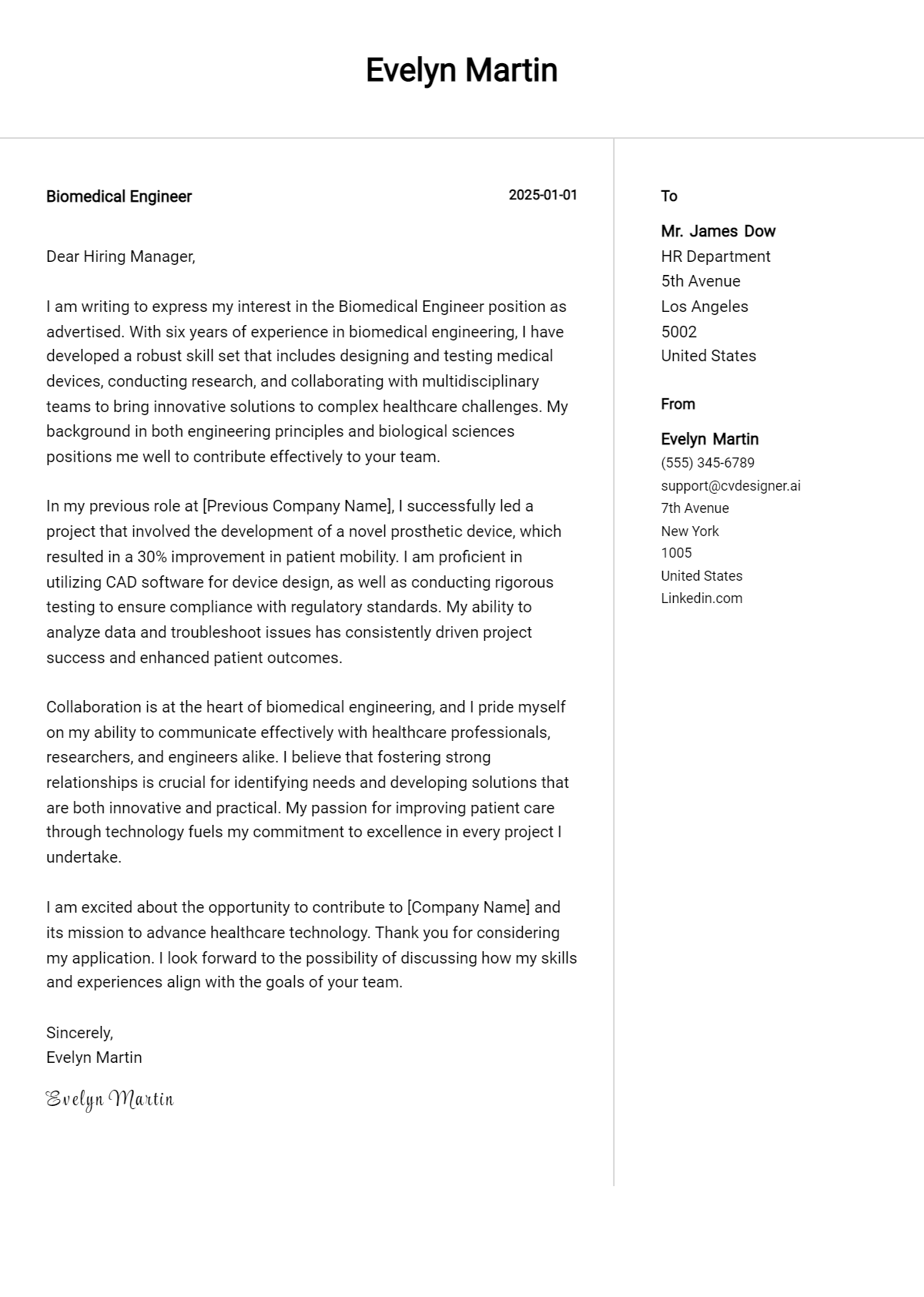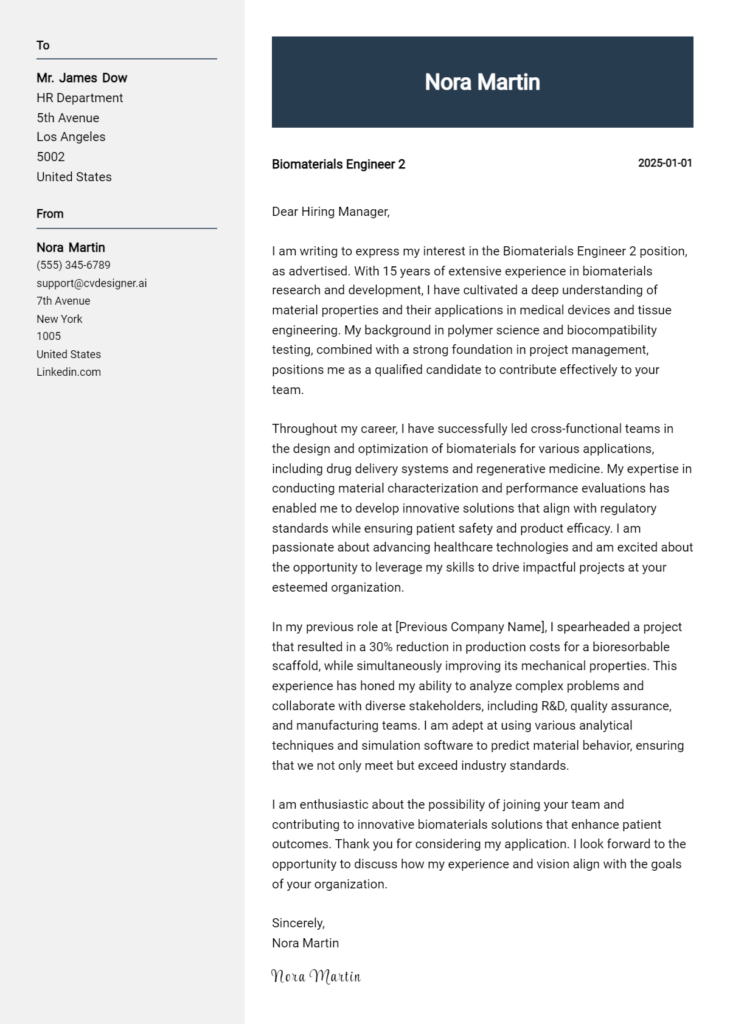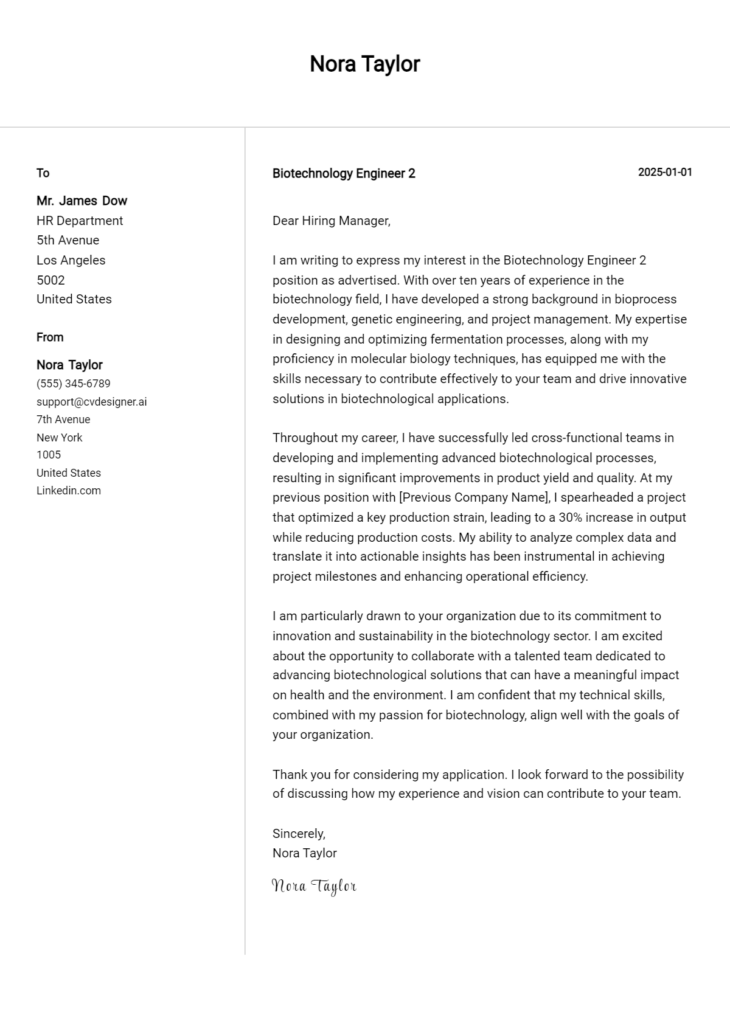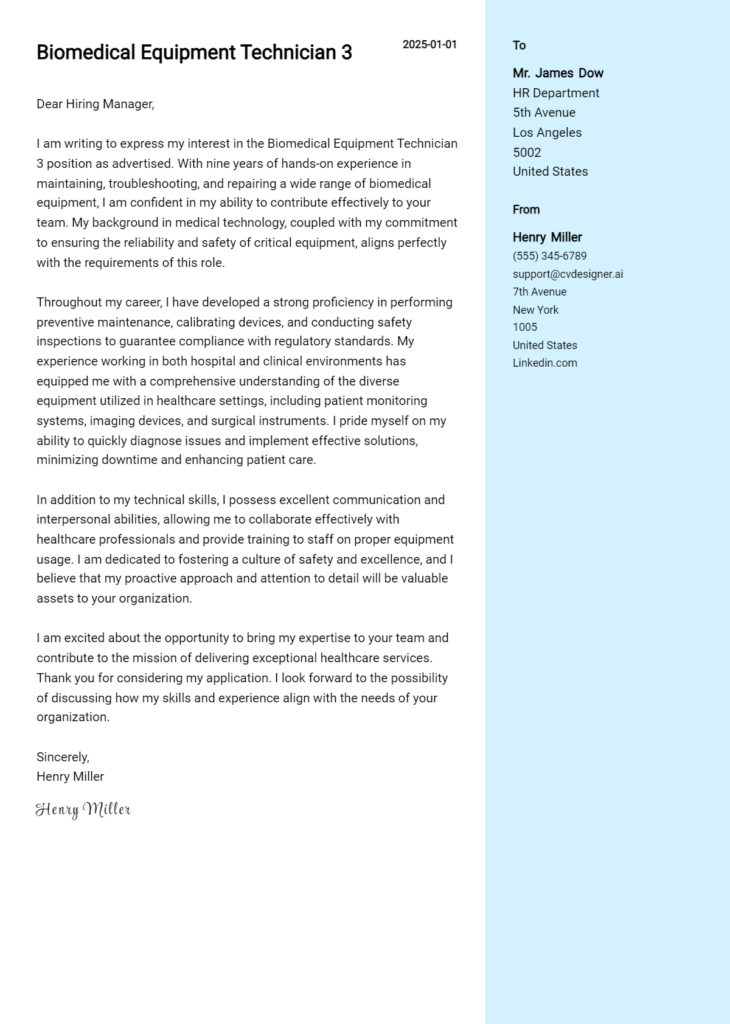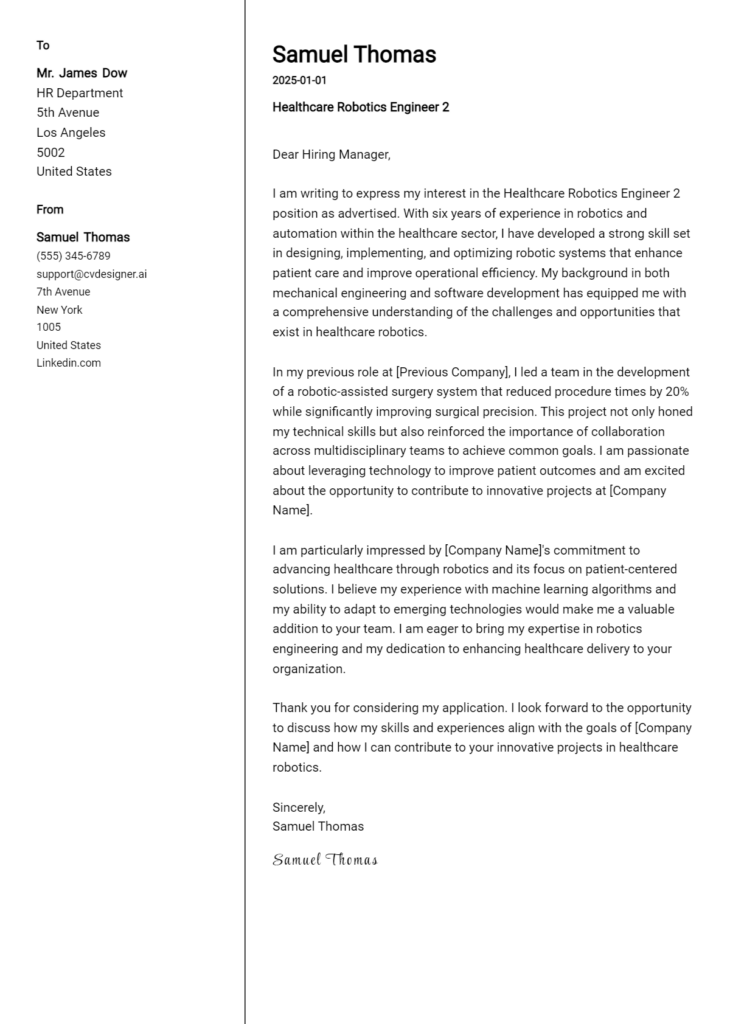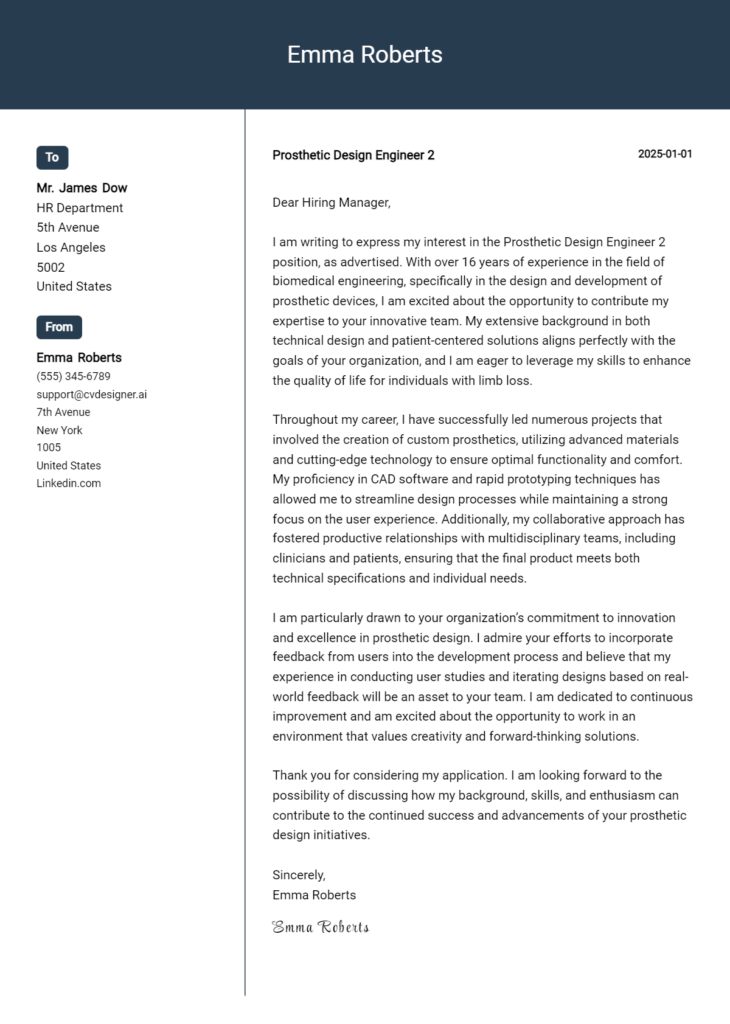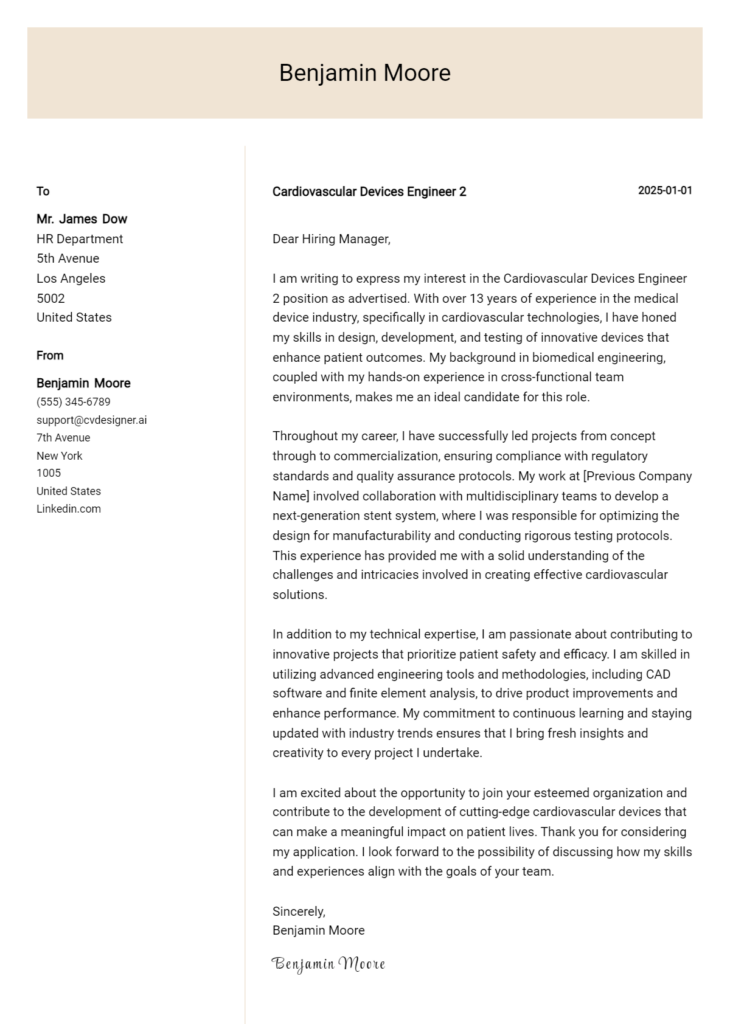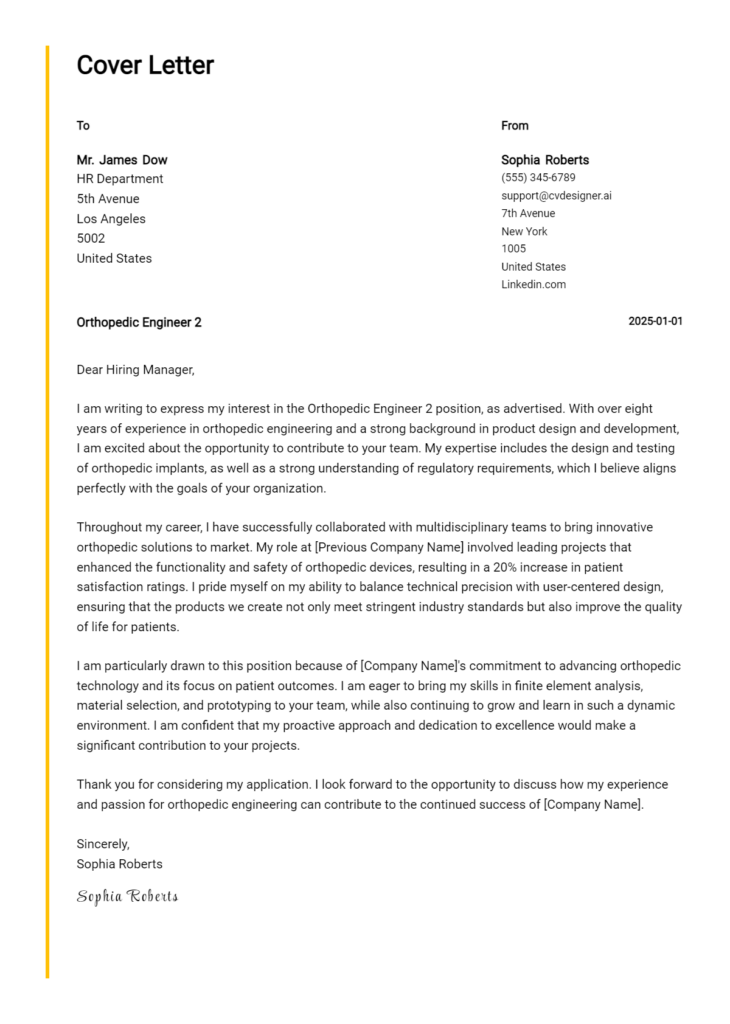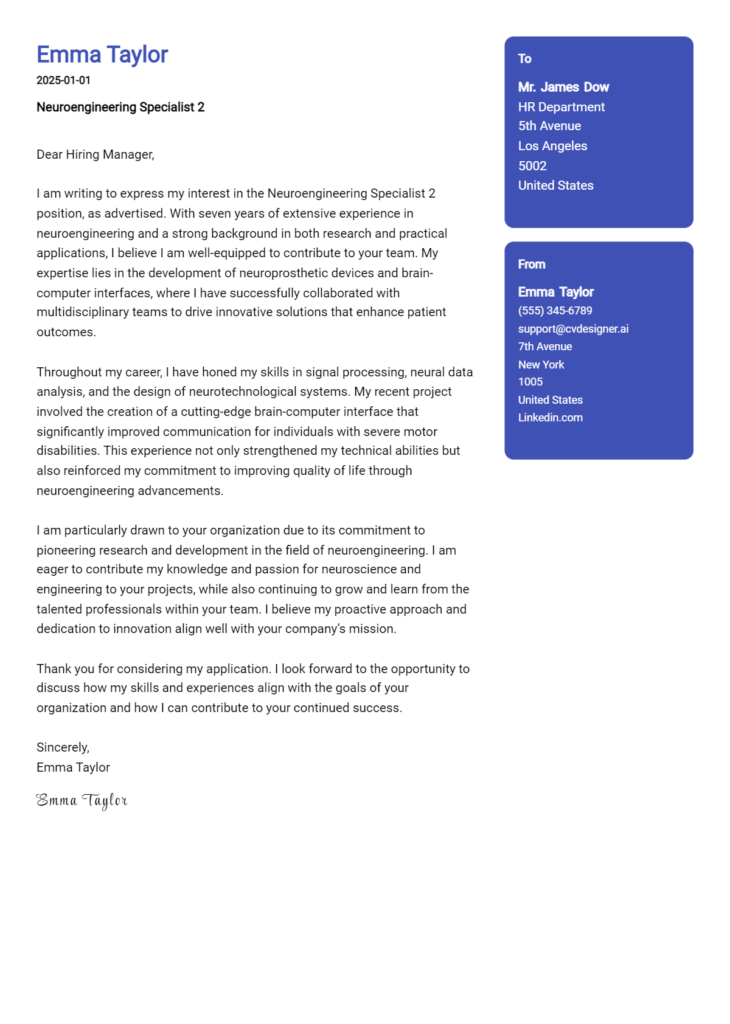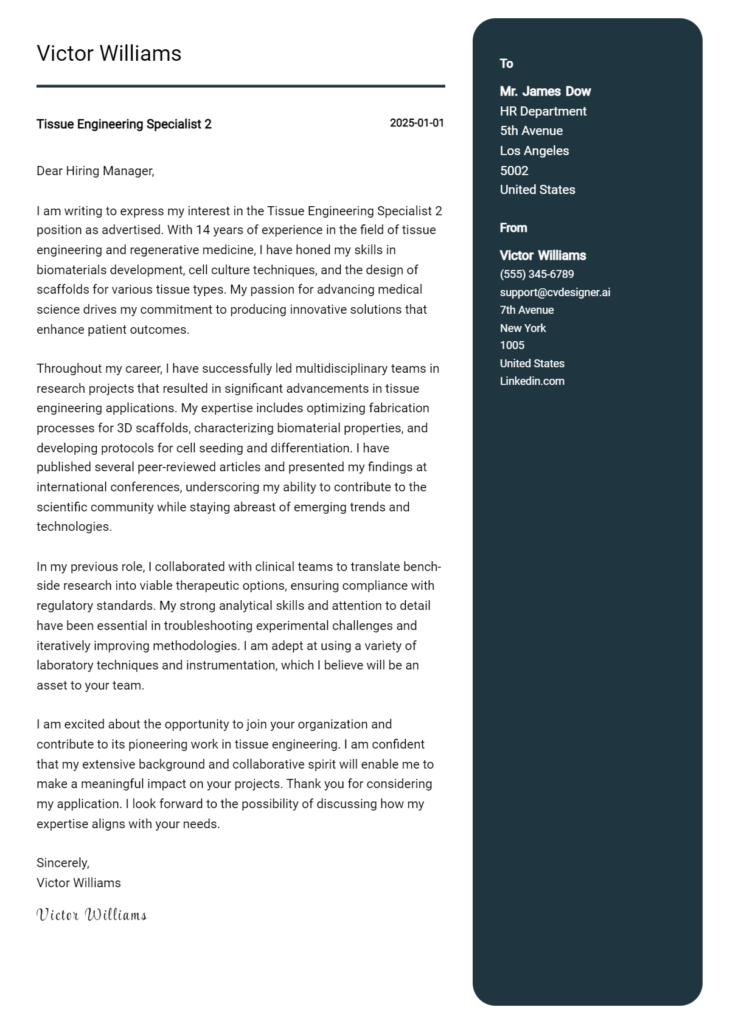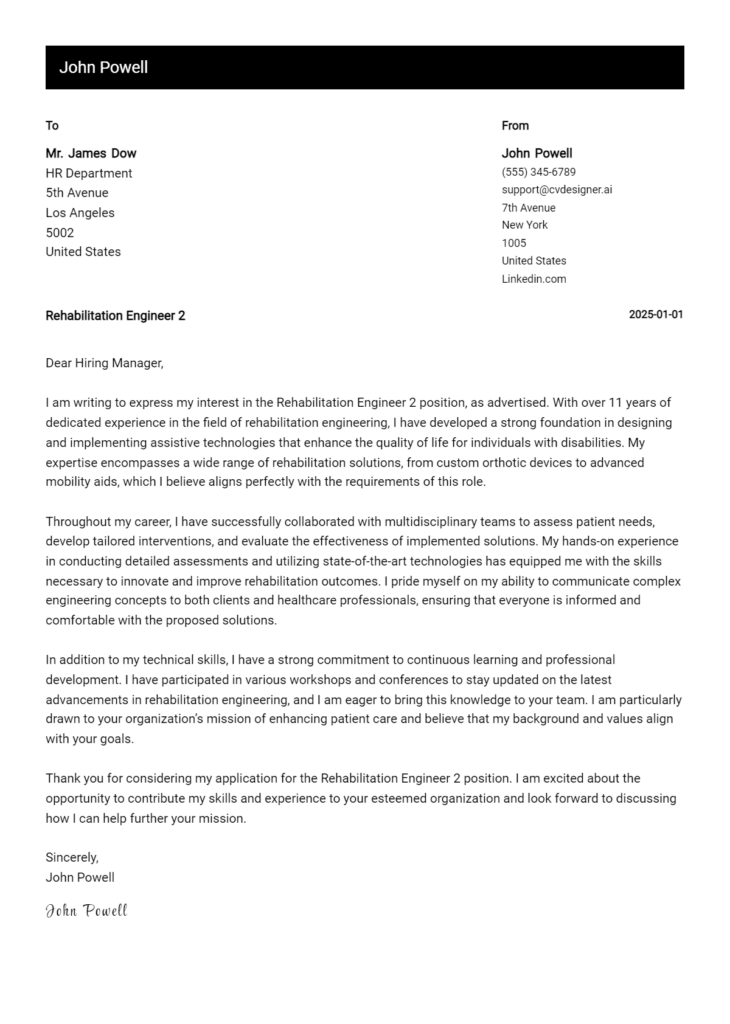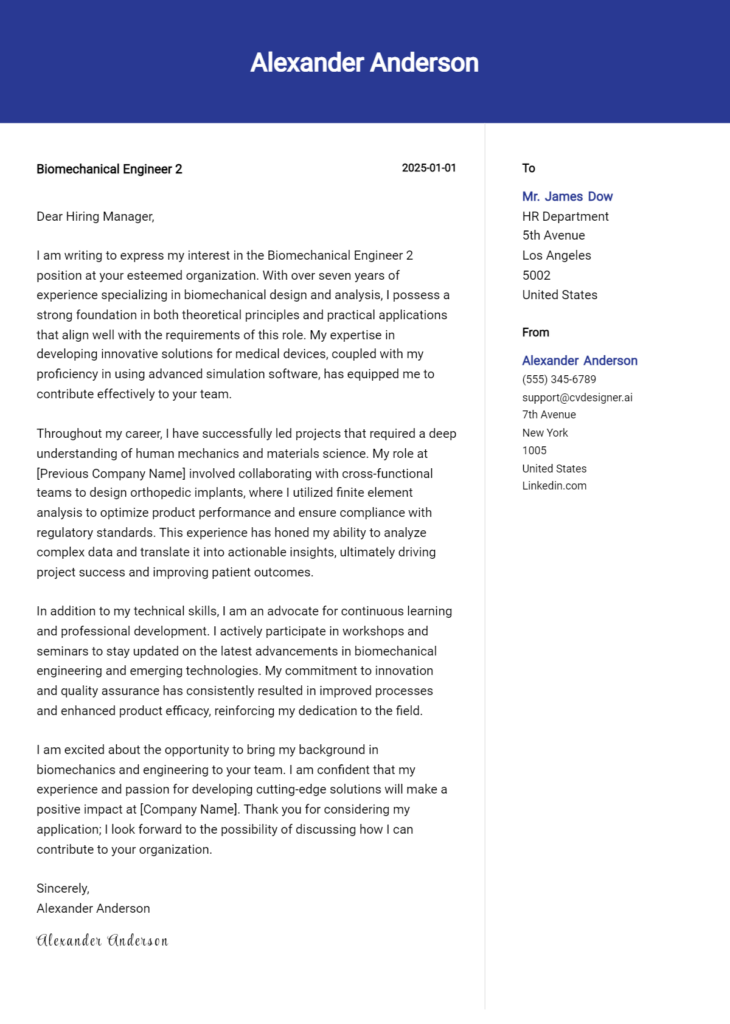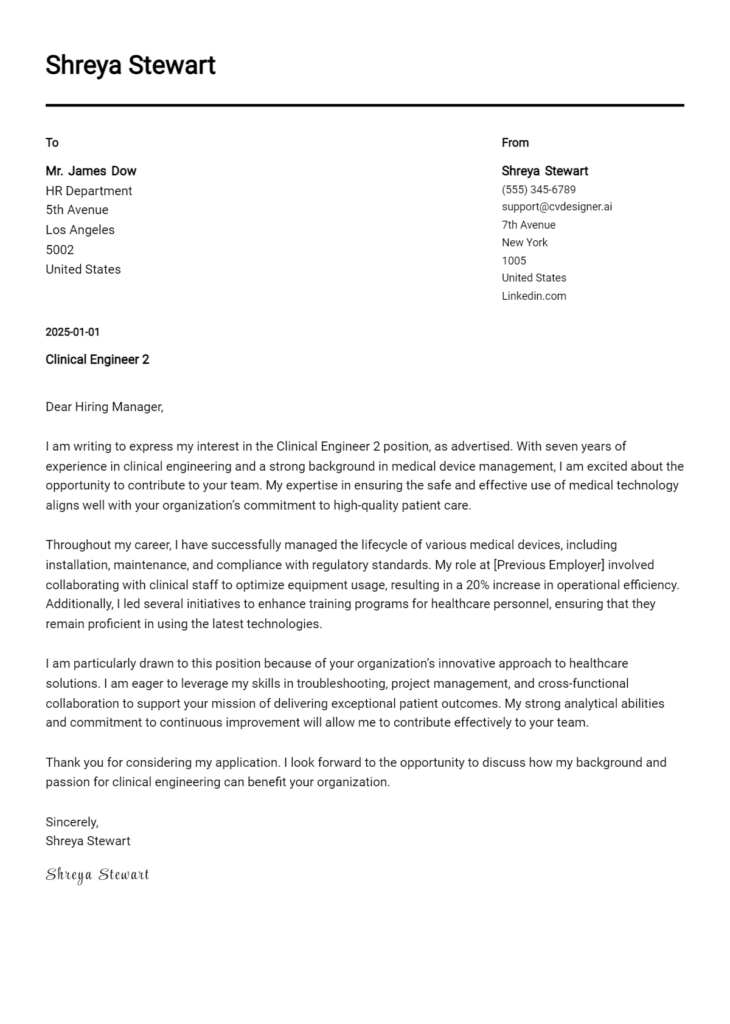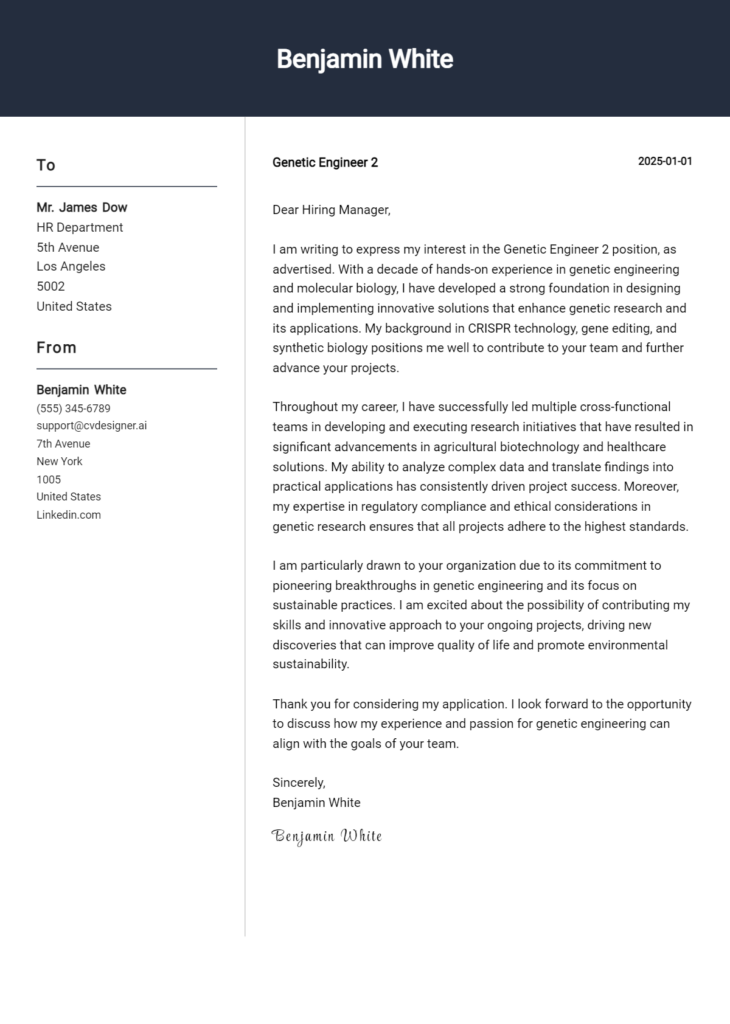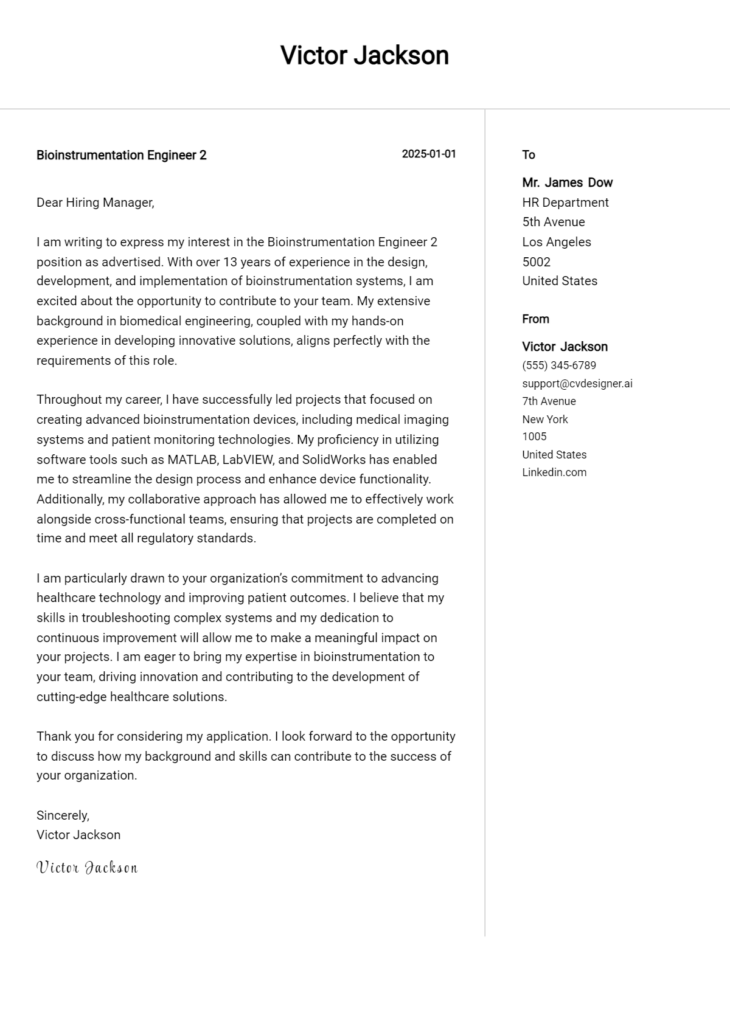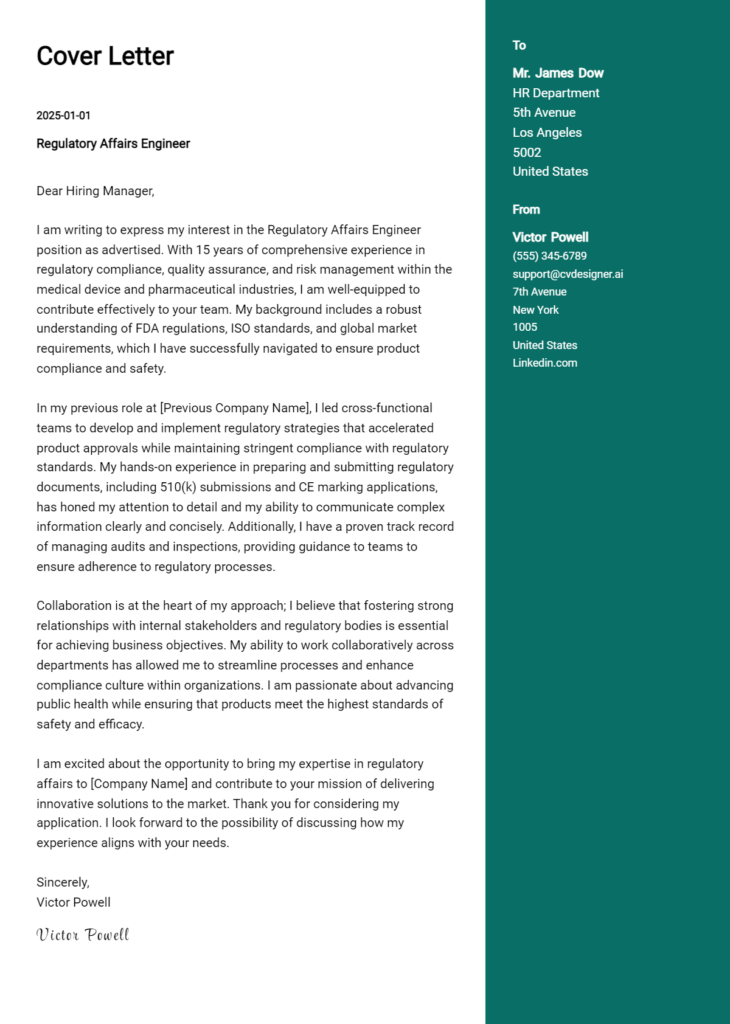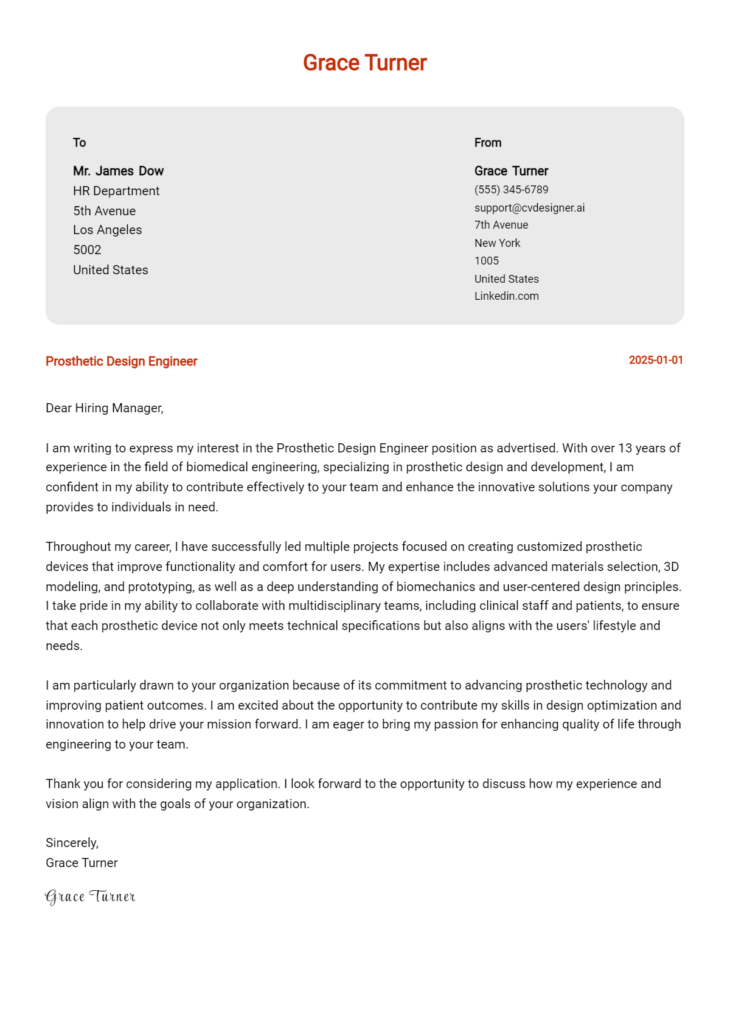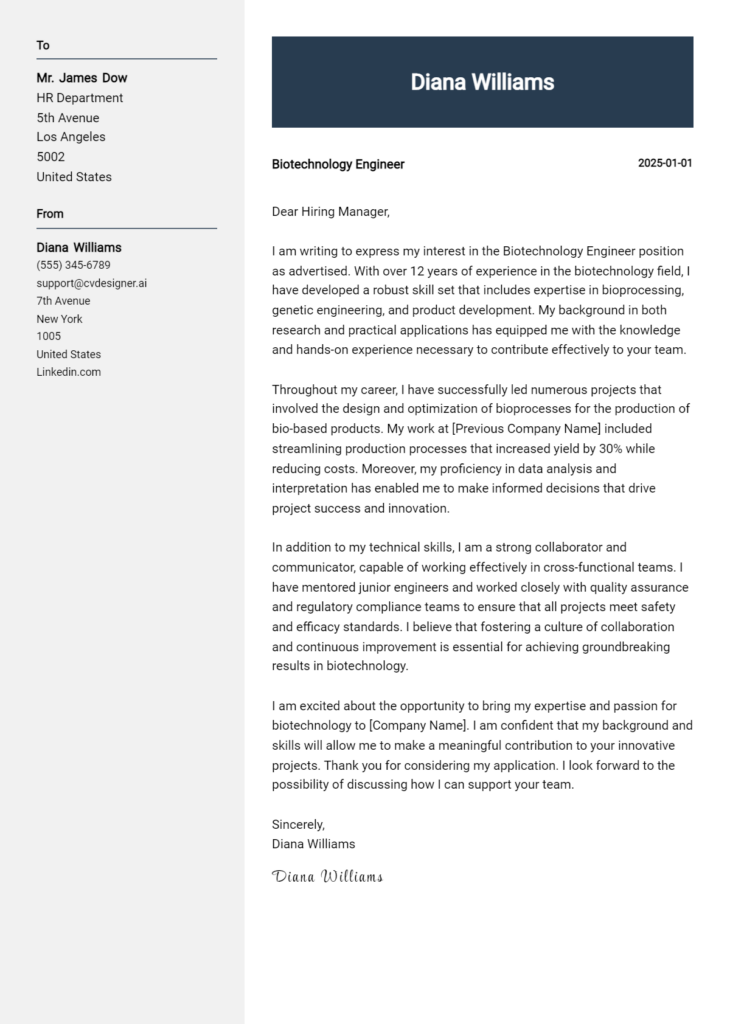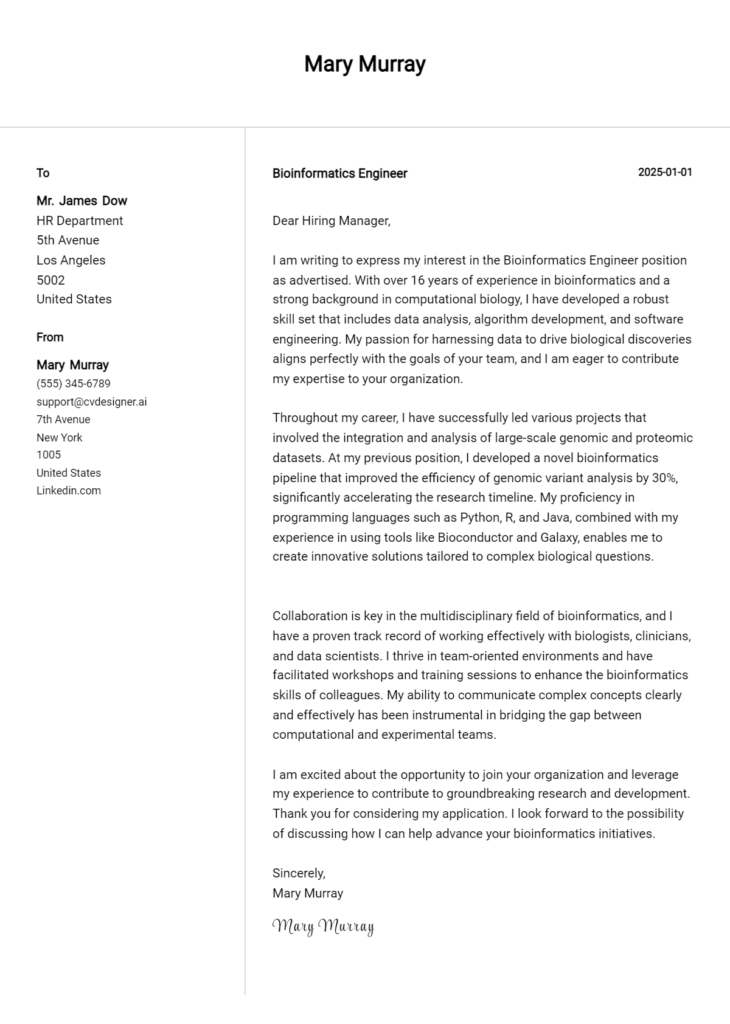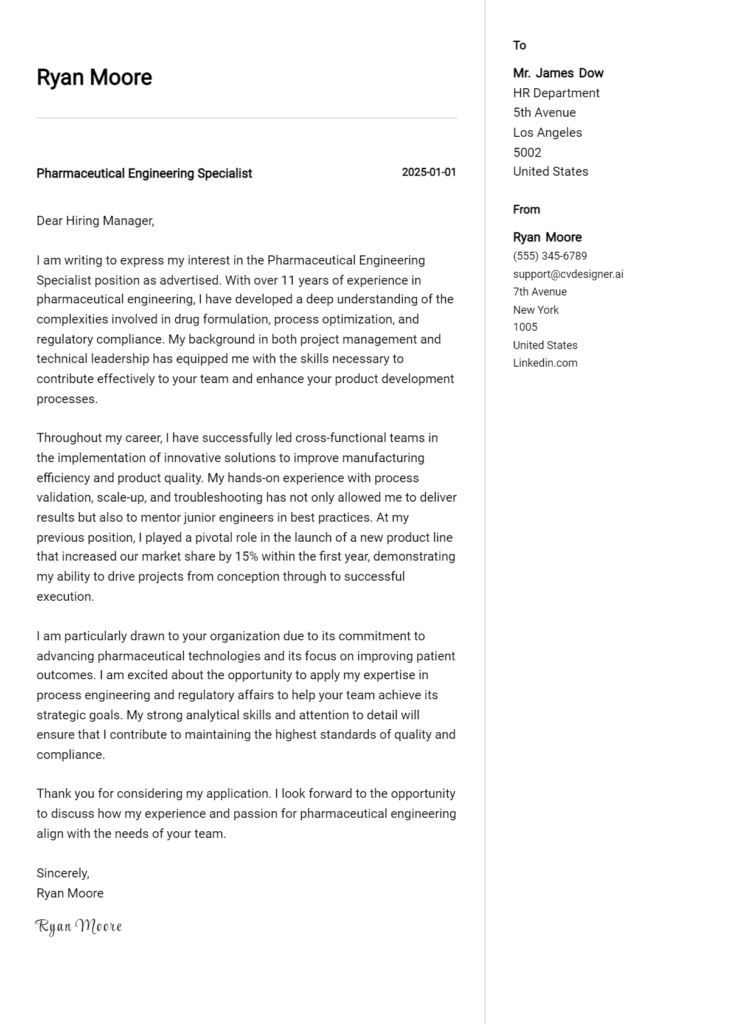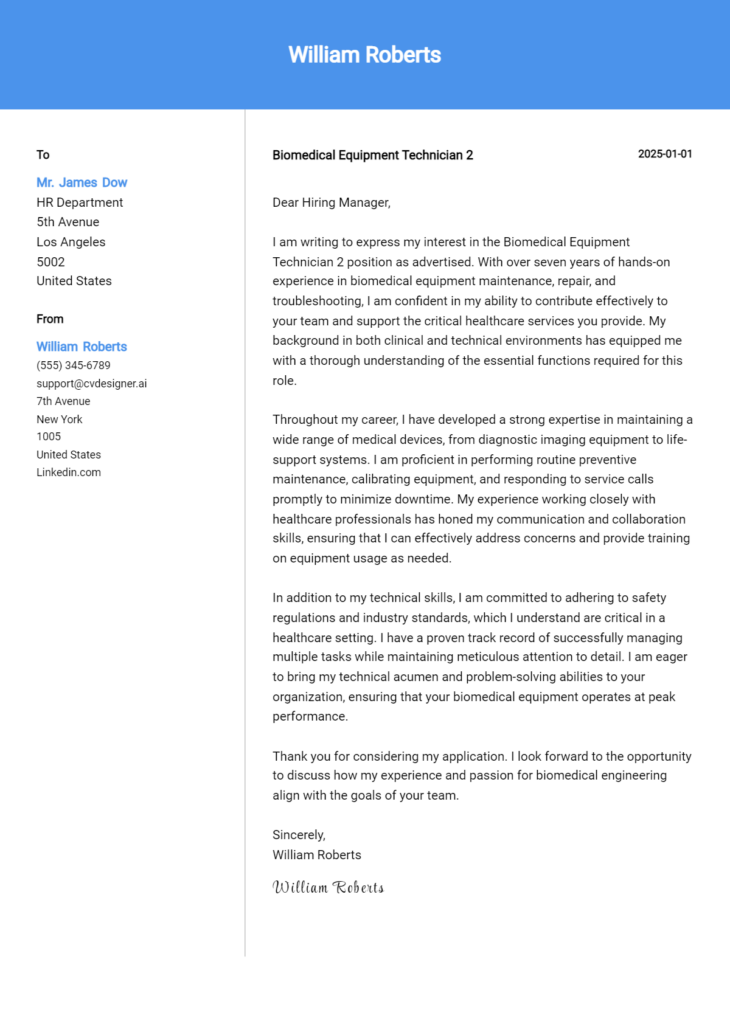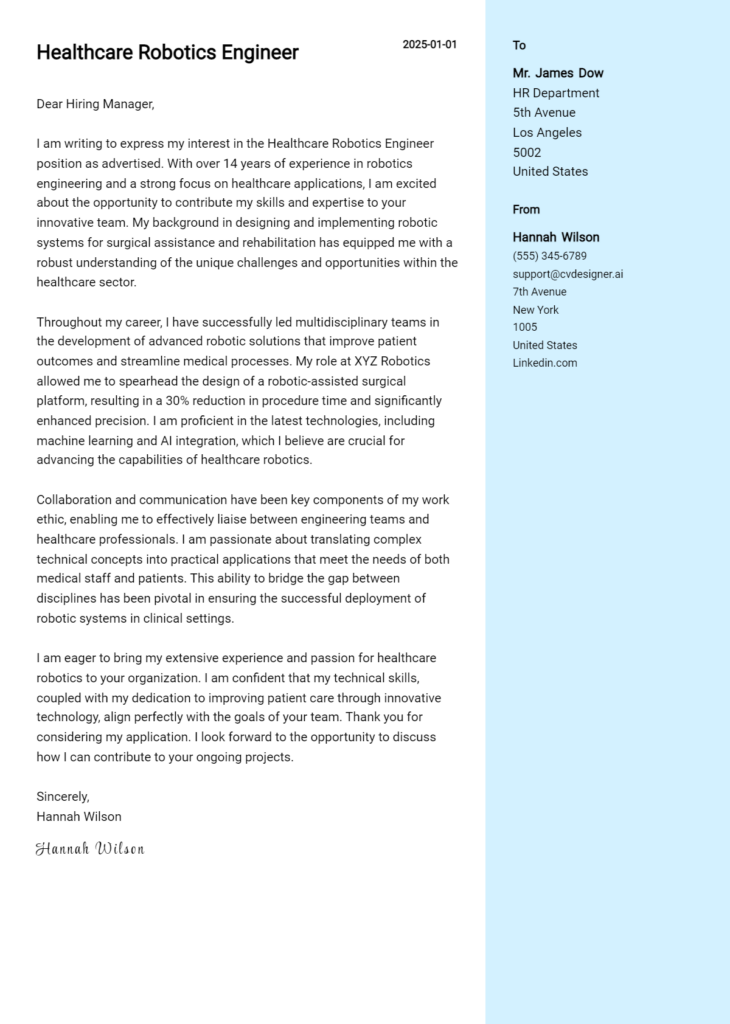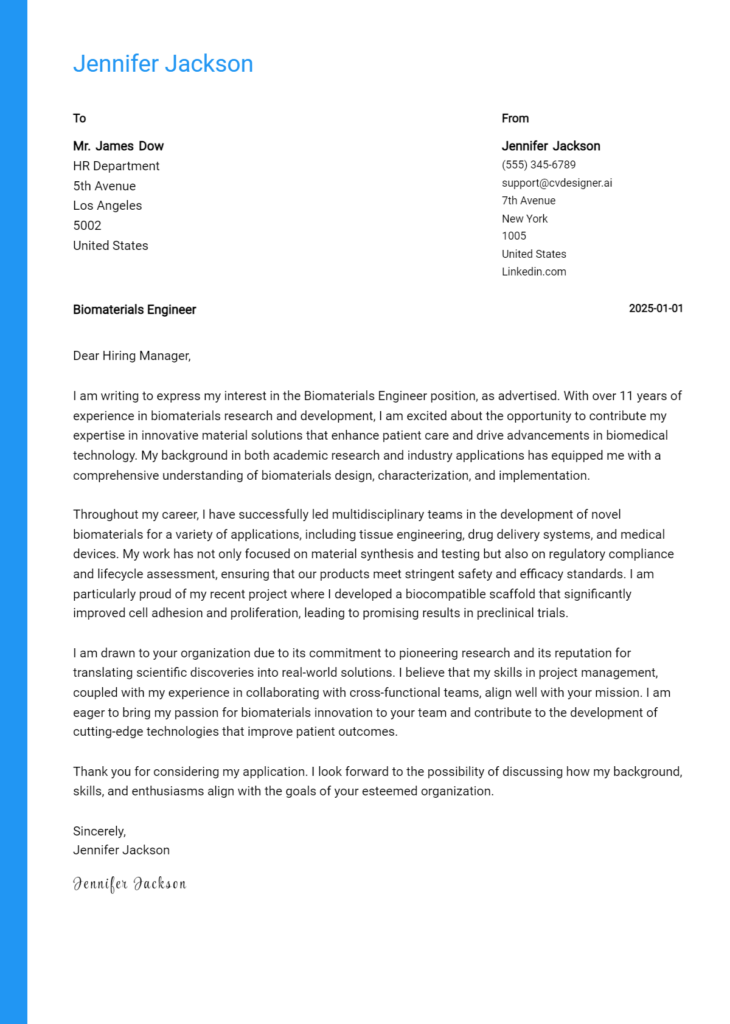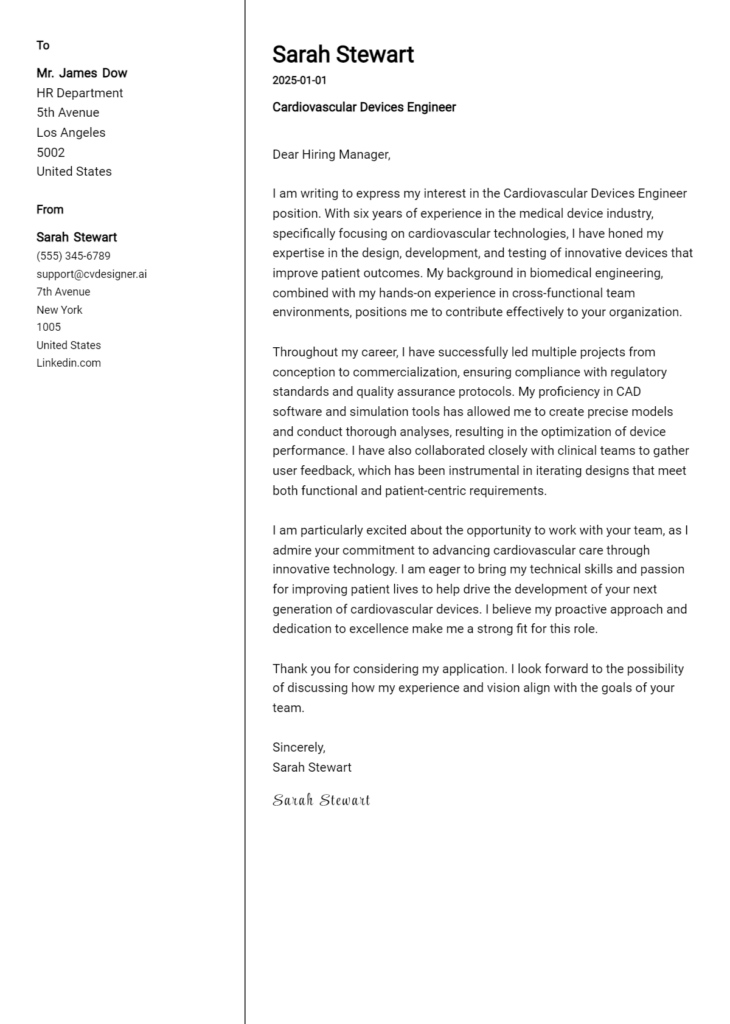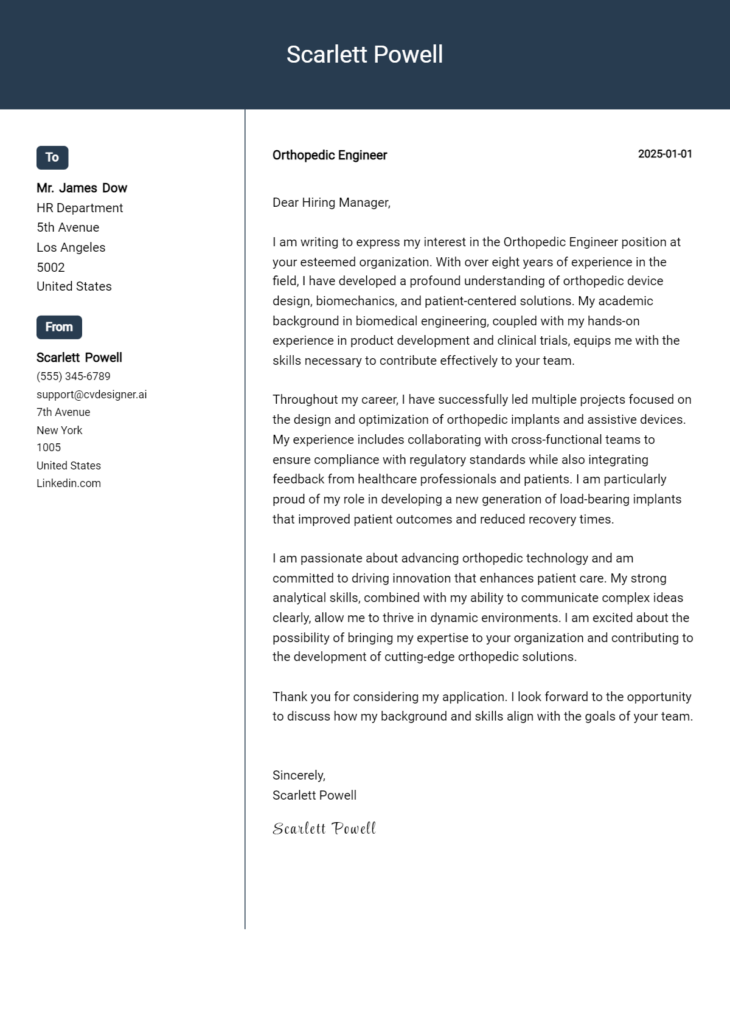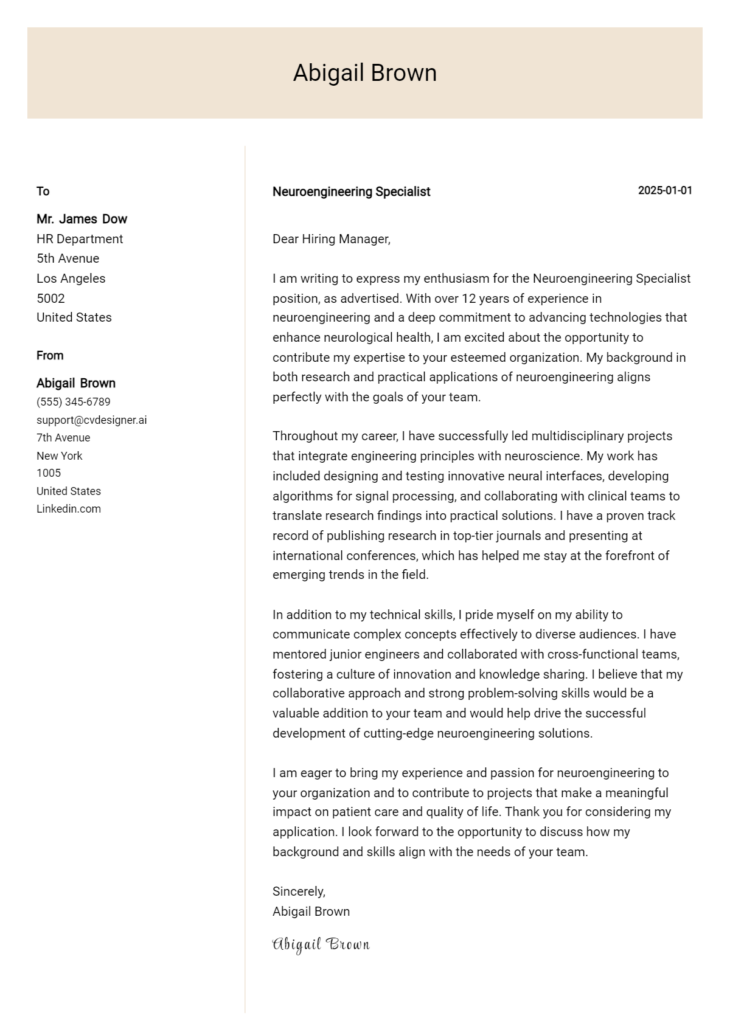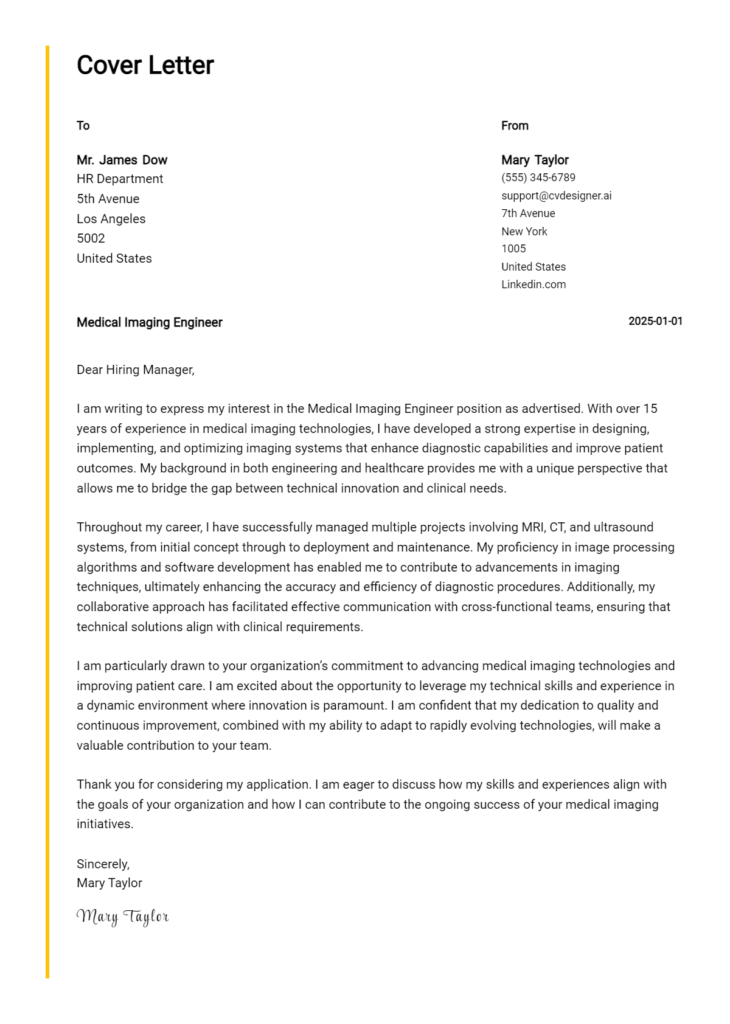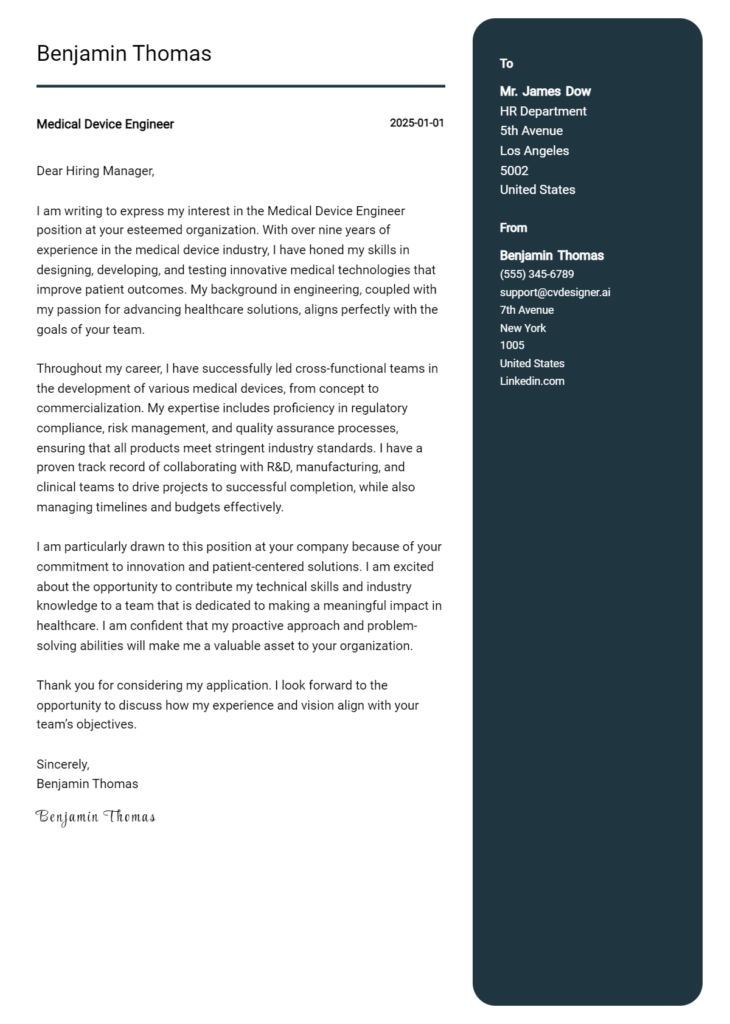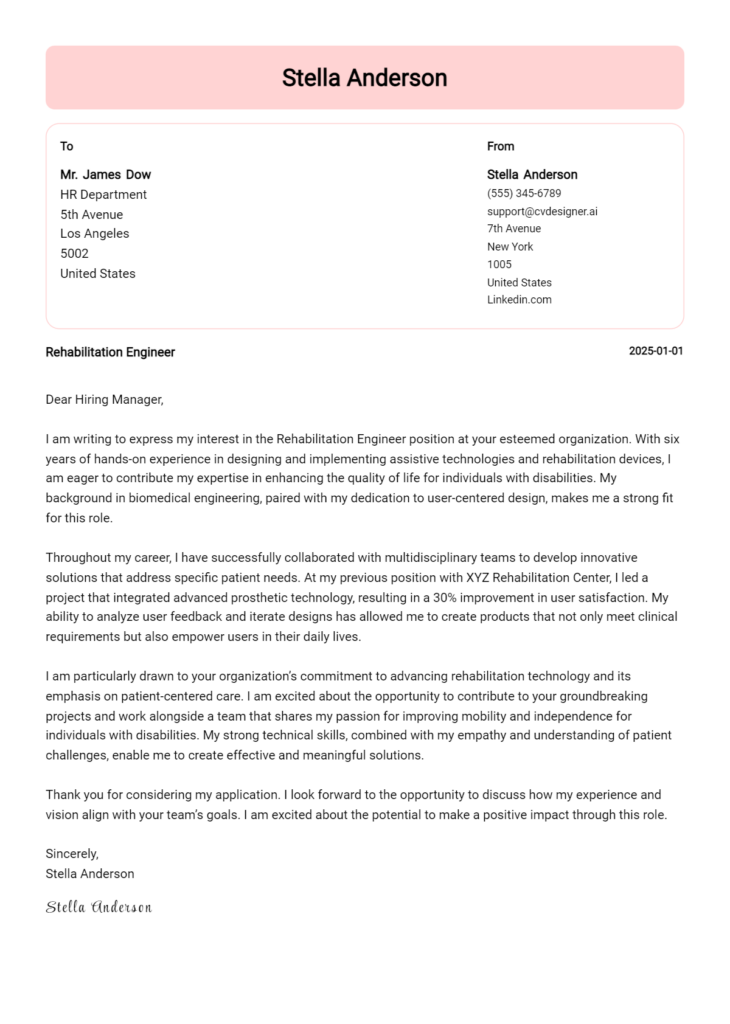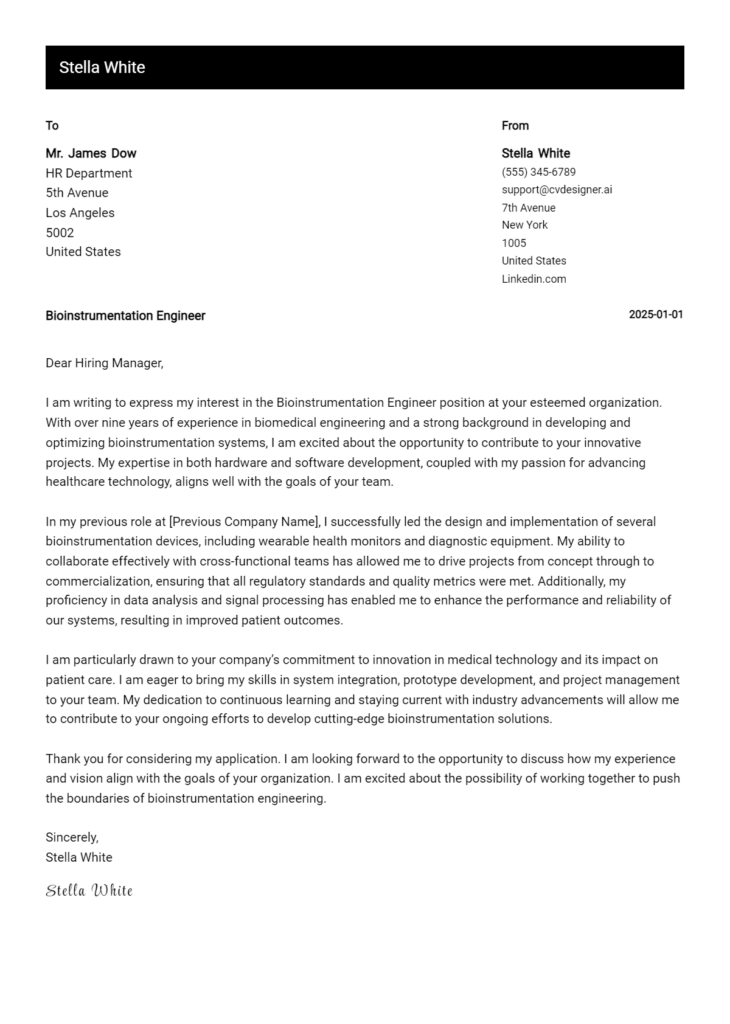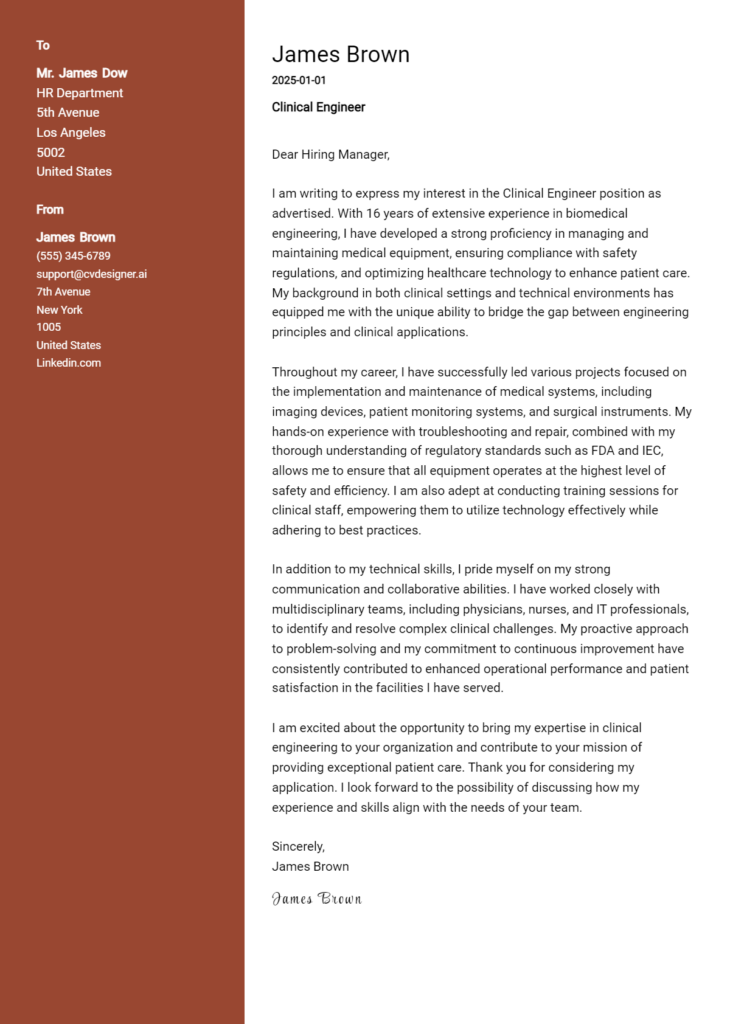Biomedical Engineer Cover Letter Examples
Explore additional Biomedical Engineer cover letter samples and guides and see what works for your level of experience or role.
How to Format a Biomedical Engineer Cover Letter?
Crafting a compelling cover letter is essential for Biomedical Engineers, as it serves as your first opportunity to showcase not only your qualifications but also your innovative thinking and problem-solving abilities. The format of your cover letter can significantly impact how hiring managers perceive your attention to detail and professionalism, traits that are paramount in the biomedical field. A well-structured cover letter not only captures the reader's attention but also effectively conveys your technical expertise and passion for improving healthcare through engineering solutions.
In this guide, we'll explore how to format your cover letter, providing insights and examples tailored specifically for Biomedical Engineers.
We will focus on the key components of a professional cover letter, including:
- Cover Letter Header
- Cover Letter Greeting
- Cover Letter Introduction
- Cover Letter Body
- Cover Letter Closing
Each section is critical to ensuring that your qualifications shine through, helping you make a strong impression in this competitive field. Let’s break down each part and discover how to create a standout cover letter that reflects your skills and enthusiasm for biomedical engineering.
Importance of the Cover Letter Header for a Biomedical Engineer
The header of a cover letter is essential as it establishes the first impression of your application. For a Biomedical Engineer, clarity and professionalism in this section are crucial, as they reflect your attention to detail and organizational skills—qualities highly valued in the engineering field. The header should include your contact information, the date, and the recipient's details. This not only aids in easy communication but also conveys a sense of formality and respect for the hiring manager's time.
Here are examples of a strong and weak cover letter header for a Biomedical Engineer:
Strong Example:
Jane Doe 123 Biomedical Lane Engineering City, CA 90210 (123) 456-7890 jane.doe@email.com October 1, 2023 Mr. John Smith Hiring Manager Innovative Medical Solutions 456 Healthcare Ave Medical Town, CA 90211
Weak Example:
jane doe biomedical engineer email: jane.doe@email.com 10/01/2023 john
The Importance of the Cover Letter Greeting for a Biomedical Engineer
The greeting of your cover letter is crucial in establishing the tone for the rest of your application. It serves as your first impression, showcasing your professionalism and ability to connect personally with the hiring manager. By addressing the recipient directly, you demonstrate respect and seriousness about the position you are applying for. To enhance this personal touch, it's essential to avoid generic greetings like "To Whom It May Concern" or "Dear Hiring Manager." Instead, take the time to research the hiring manager's name, which can often be found on the company’s website or through professional networking platforms. This effort not only sets a positive tone but also shows your genuine interest in the role and the organization.
Strong Greeting Example
Dear Dr. Smith,
Weak Greeting Example
To Whom It May Concern,
The Importance of a Compelling Cover Letter Introduction for Biomedical Engineers
A well-crafted cover letter introduction is crucial for Biomedical Engineers seeking to make a strong impression on hiring managers. This section serves as the first point of contact, where candidates have the opportunity to capture the reader's attention and express genuine interest in the position. A compelling introduction not only highlights the candidate's enthusiasm for the role but also briefly showcases key skills or achievements that align with the job requirements. This sets the tone for the rest of the letter, encouraging the hiring manager to continue reading and consider the candidate for the position. Below are examples of strong and weak cover letter introductions for a Biomedical Engineer.
Strong Example
Dear Hiring Manager, I am excited to apply for the Biomedical Engineer position at Innovate Medical Solutions, as advertised on your careers page. With a Master’s degree in Biomedical Engineering and over five years of hands-on experience in developing cutting-edge medical devices, I am eager to contribute my expertise in design and regulatory compliance to your innovative team. My recent project, which improved patient outcomes by 30% through a new cardiac monitoring system, showcases my commitment to advancing healthcare technology and my ability to work collaboratively in fast-paced environments.
Weak Example
To whom it may concern, I am writing to express my interest in the Biomedical Engineer position. I have a degree in Biomedical Engineering and some experience in the field. I think I could do well in this job, as I have worked on a few projects in school.
Purpose of the Cover Letter Body for a Biomedical Engineer
The cover letter body for a Biomedical Engineer serves as a critical space to articulate the candidate's relevant skills, experiences, and unique value proposition to the prospective employer. This section allows the candidate to highlight specific projects or accomplishments that demonstrate their technical expertise and problem-solving abilities. By detailing their contributions to past projects, such as the development of a novel medical device or successful collaboration on a research initiative, the candidate can effectively convey their potential impact within the company. A well-crafted cover letter body not only showcases qualifications but also connects the candidate's background to the needs and goals of the organization, ultimately making a compelling case for their employment.
Strong Example
Dear Hiring Manager, I am excited to apply for the Biomedical Engineer position at XYZ Corporation. In my previous role at ABC Technologies, I led a team in the development of a cutting-edge prosthetic limb that improved user mobility by 30%. This project not only honed my skills in CAD design and materials science but also taught me the importance of user-centered design. My contributions were recognized with the Innovation Award for Excellence in Engineering, and I am eager to bring this same level of commitment and creativity to your team. Additionally, my experience collaborating with cross-disciplinary teams has equipped me with the communication skills necessary to thrive in a dynamic work environment. Sincerely, [Your Name]
Weak Example
Dear Hiring Manager, I am writing to express my interest in the Biomedical Engineer position. I have a degree in biomedical engineering and some experience. In my last job, I helped with some projects. I think I would be a good fit for your company. I am a hard worker and I really like science. Best, [Your Name]
Importance of Cover Letter Closing for a Biomedical Engineer
The closing paragraph of a cover letter is a crucial component that leaves a lasting impression on potential employers. For a Biomedical Engineer, it should succinctly summarize your qualifications, reiterate your enthusiasm for the position, and encourage the next steps, such as reviewing your resume or scheduling an interview. A strong closing not only reinforces your fit for the role but also demonstrates your proactive approach and eagerness to contribute to the organization. Below are examples of strong and weak closing paragraphs for a Biomedical Engineer's cover letter.
Strong Example
Thank you for considering my application for the Biomedical Engineer position. With a solid background in medical device design and a passion for improving patient outcomes, I am excited about the opportunity to contribute to your team at InnovateMed. I am eager to discuss how my skills in project management and innovative problem-solving can benefit your organization. Please feel free to review my resume for more details, and I hope to schedule an interview soon to further explore how I can support your mission.
Weak Example
I think I would be a good fit for the job. Please look at my resume. Let me know if you want to talk.
Crafting an effective cover letter is essential for Biomedical Engineers looking to stand out in a competitive job market. A well-written cover letter not only introduces your qualifications but also showcases your technical skills, problem-solving abilities, knowledge of the Software Development Life Cycle (SDLC), teamwork experience, and a passion for continuous learning. Below are some tips to help you create a compelling cover letter that highlights these important aspects.
Tips for Writing a Biomedical Engineer Cover Letter
Highlight Technical Skills
Clearly outline your technical skills relevant to the position, such as proficiency in medical imaging software, bioinformatics, or device design. Use specific examples to demonstrate how you've applied these skills in previous roles or projects. Mention any certifications or training that add credibility to your expertise.Emphasize Problem-Solving Abilities
Biomedical engineering often involves tackling complex problems. In your cover letter, provide an example of a challenging situation you faced and how you successfully resolved it. This could involve designing a solution for a medical device issue or optimizing a process in a lab setting. Highlight the impact of your solution on the project or the team.Showcase Knowledge of SDLC
If the job description mentions experience with the Software Development Life Cycle, make sure to discuss your familiarity with this process. Explain your role in the development of software for medical devices or systems, and how you contribute to each stage from requirements gathering to testing and maintenance. This insight shows potential employers your understanding of the broader context of your work.Demonstrate Teamwork and Collaboration
Biomedical engineers often work in multidisciplinary teams. Highlight your experience in collaborating with professionals from various fields, such as physicians, researchers, and software developers. Share a specific example where your teamwork led to a successful project outcome, emphasizing your ability to communicate effectively and work towards a common goal.Express Passion for Continuous Learning
The field of biomedical engineering is constantly evolving, and showing a commitment to continuous learning can set you apart. Mention any recent courses, workshops, or certifications you have pursued to enhance your knowledge and skills. This demonstrates your dedication to staying current with industry trends and advancements, which is crucial for innovation in this field.
By integrating these elements into your cover letter, you can create a strong narrative that appeals to hiring managers. If you're looking for more guidance, consider using cover letter templates or a cover letter builder to streamline your writing process and ensure your letter is polished and professional.
Common Mistakes to Avoid in a Biomedical Engineer Cover Letter
Crafting a compelling cover letter is essential for a successful job application as a Biomedical Engineer. Avoiding common mistakes can significantly enhance your chances of standing out to potential employers. Here are some frequent pitfalls to watch out for:
Generic Content: Using a one-size-fits-all approach can be detrimental. Tailor your cover letter to the specific position and company by highlighting relevant skills and experiences.
Ignoring Formatting Guidelines: Not adhering to a professional cover letter format can make your application look unpolished. Ensure your layout is clean and follows standard cover letter format.
Lack of Specific Examples: Vague statements about your qualifications can weaken your letter. Use specific examples to illustrate your achievements and skills in biomedical engineering.
Overly Technical Language: While it's important to showcase your expertise, using excessive jargon may alienate readers. Strike a balance by explaining technical terms when necessary.
Neglecting Proofreading: Typos and grammatical errors can undermine your professionalism. Always proofread your cover letter or have someone else review it before submission.
Not Conveying Passion: Failing to express genuine interest in the field can make your application forgettable. Share what excites you about biomedical engineering and the specific role.
Omitting a Call to Action: Concluding without a clear call to action can leave your letter feeling incomplete. Encourage the reader to contact you for further discussion about your qualifications.
By avoiding these common mistakes, and referring to cover letter examples for inspiration, you can create a stronger, more effective cover letter that helps you land your desired position.
Cover Letter FAQs for Biomedical Engineer
What should I include in my cover letter as a Biomedical Engineer?
In your cover letter, it’s essential to showcase your technical skills and relevant experience. Start by introducing yourself and expressing your enthusiasm for the position. Highlight your educational background, particularly any degrees in biomedical engineering or related fields. Mention specific projects or internships where you applied engineering principles to solve medical problems. Additionally, emphasize your proficiency with tools like CAD software, biomedical imaging, or regulatory compliance. Tailor your cover letter to the job description by aligning your skills with the company’s needs, demonstrating your understanding of their products or research focus.
How can I demonstrate my passion for biomedical engineering in my cover letter?
To convey your passion for biomedical engineering, share personal anecdotes that illustrate your commitment to the field. Discuss any volunteer work, internships, or projects that inspired you or allowed you to contribute to healthcare solutions. Mention any relevant organizations you are part of, such as biomedical societies, and any conferences you’ve attended. Articulate your long-term career goals and how they align with the company’s mission. Show enthusiasm by explaining why you are drawn to their specific projects or technologies, which can help convey your genuine interest in making a difference through your work.
Should I use technical jargon in my cover letter?
While it’s important to demonstrate your technical expertise, using excessive jargon can alienate non-technical readers, such as HR professionals. Strive for a balance by incorporating key technical terms relevant to the role while maintaining clarity. Use layman’s terms to explain complex concepts, ensuring your cover letter is accessible to all readers. This approach will highlight your knowledge without overwhelming the reader. Tailor your language to the job description, ensuring you address the specific skills and technologies mentioned while keeping the overall tone professional and focused on your contributions.
How can I make my cover letter stand out?
To make your cover letter stand out, start with a compelling opening that grabs attention. Personalize it by addressing the hiring manager by name, if possible. Use specific examples from your experience to illustrate your accomplishments and impact. Instead of generic statements, quantify your achievements, such as improvements in design efficiency or successful project outcomes. Incorporate your understanding of the company’s goals and how your skills can contribute to their success. Finally, maintain a professional but engaging tone, and conclude with a strong call to action, expressing your eagerness to discuss your application further in an interview.
Build your Cover Letter in minutes
Use an AI-powered cover letter builder and have your letter done in 5 minutes. Just select your template and our software will guide you through the process.

